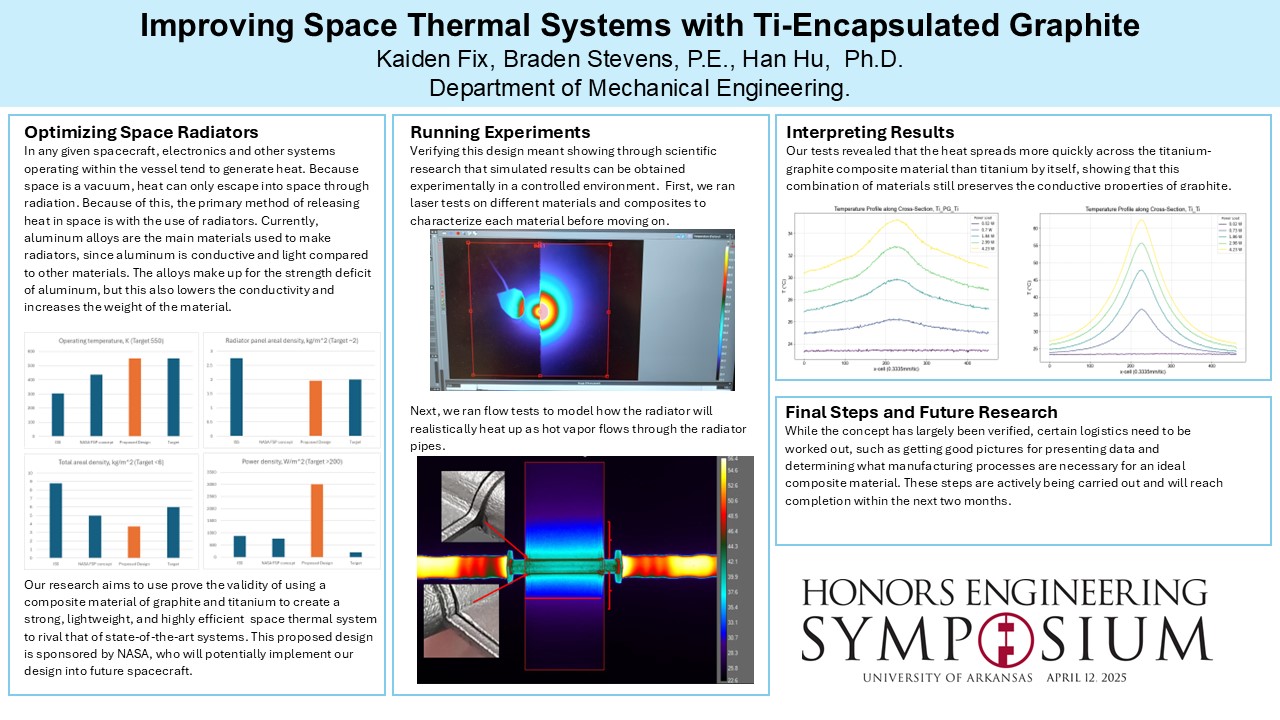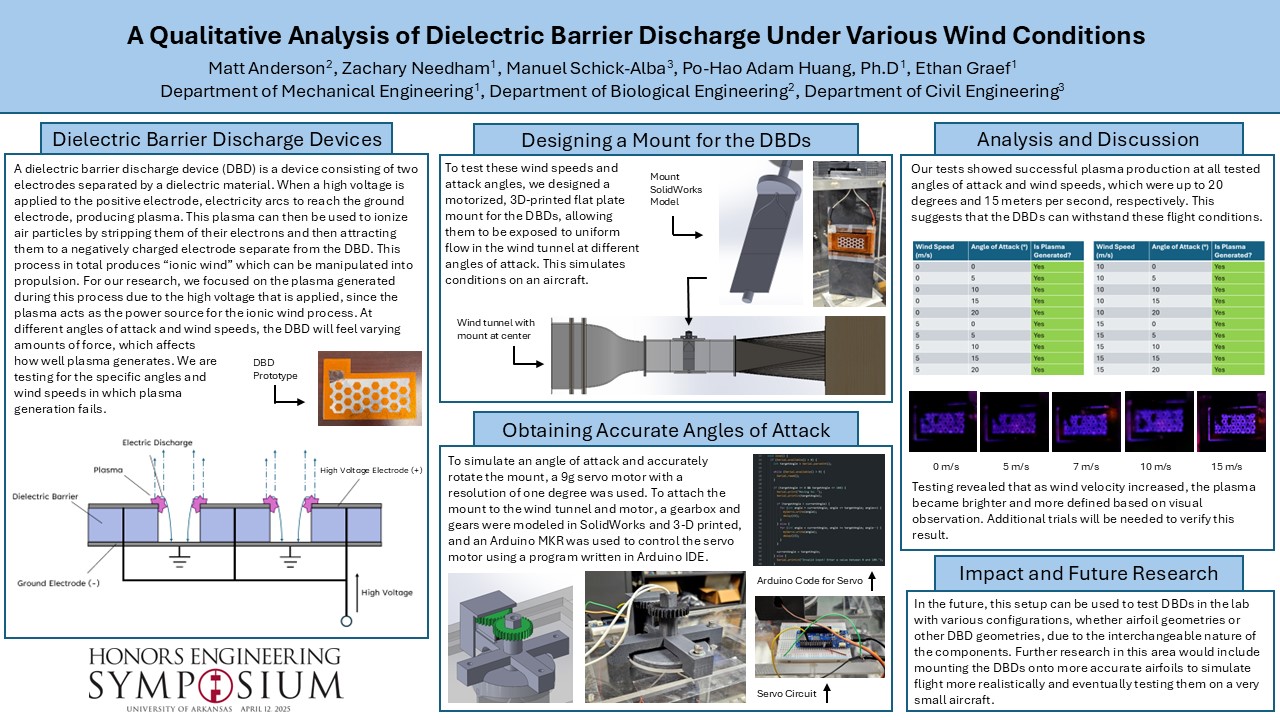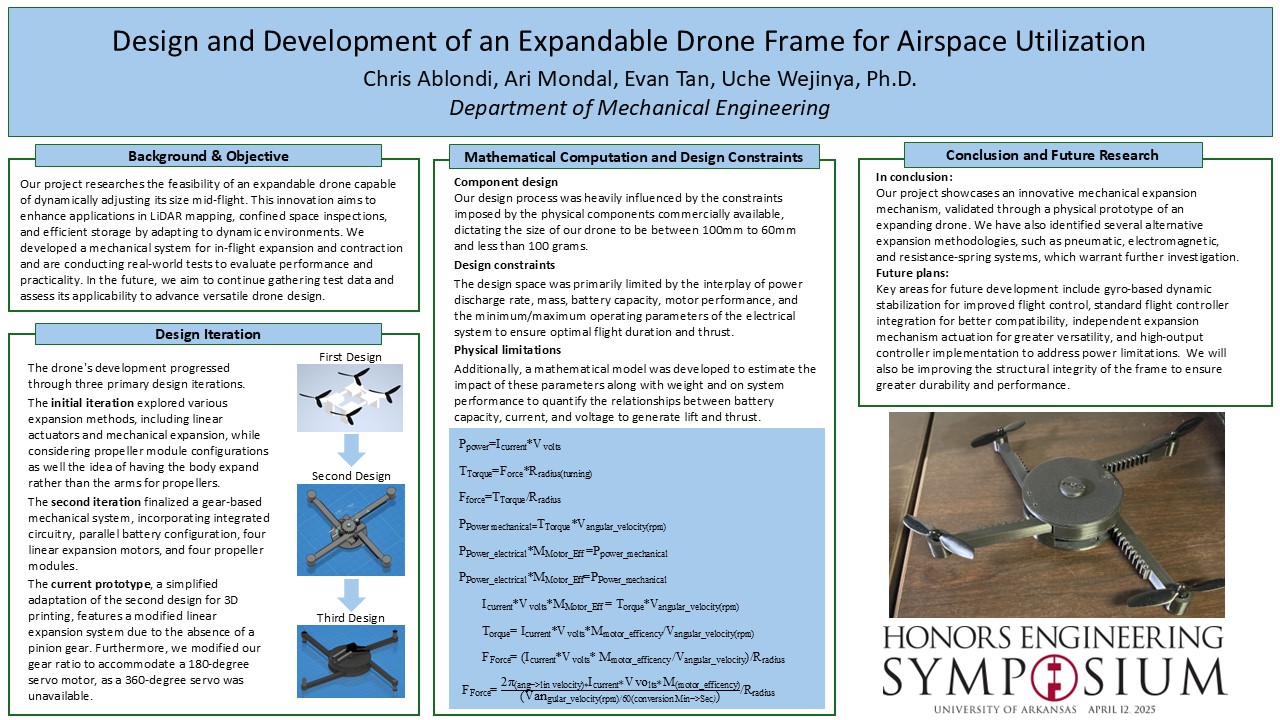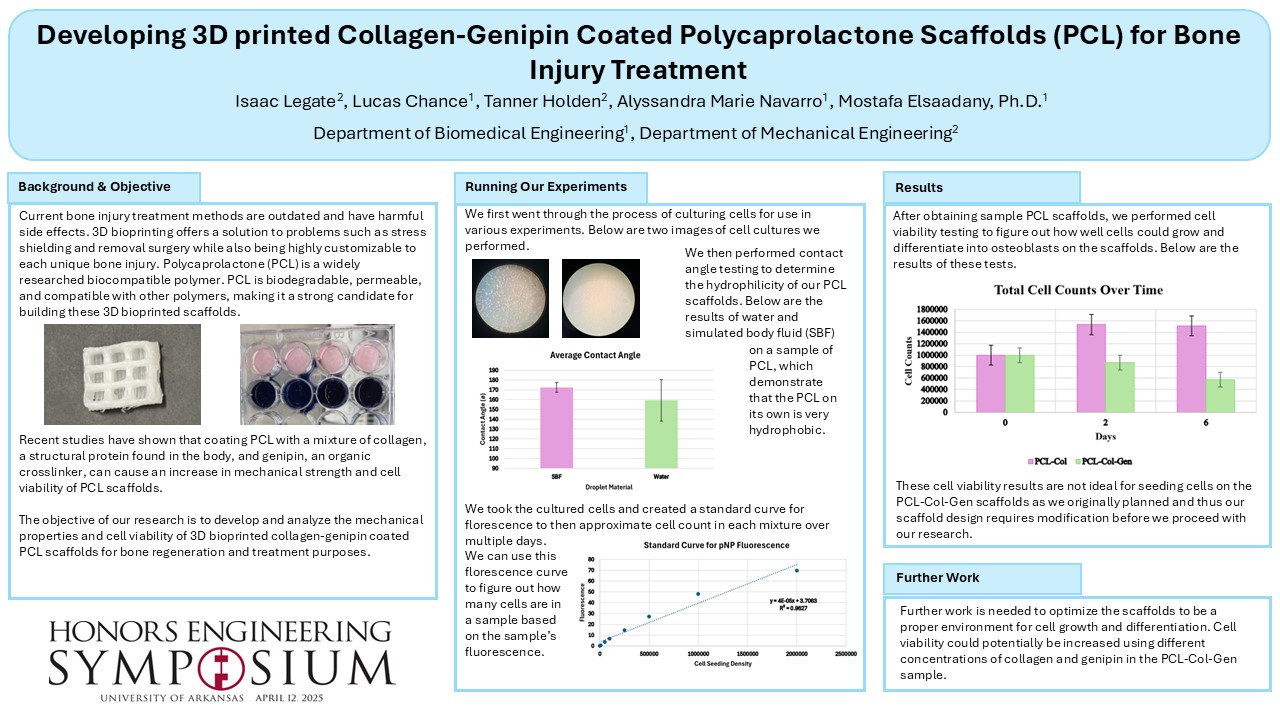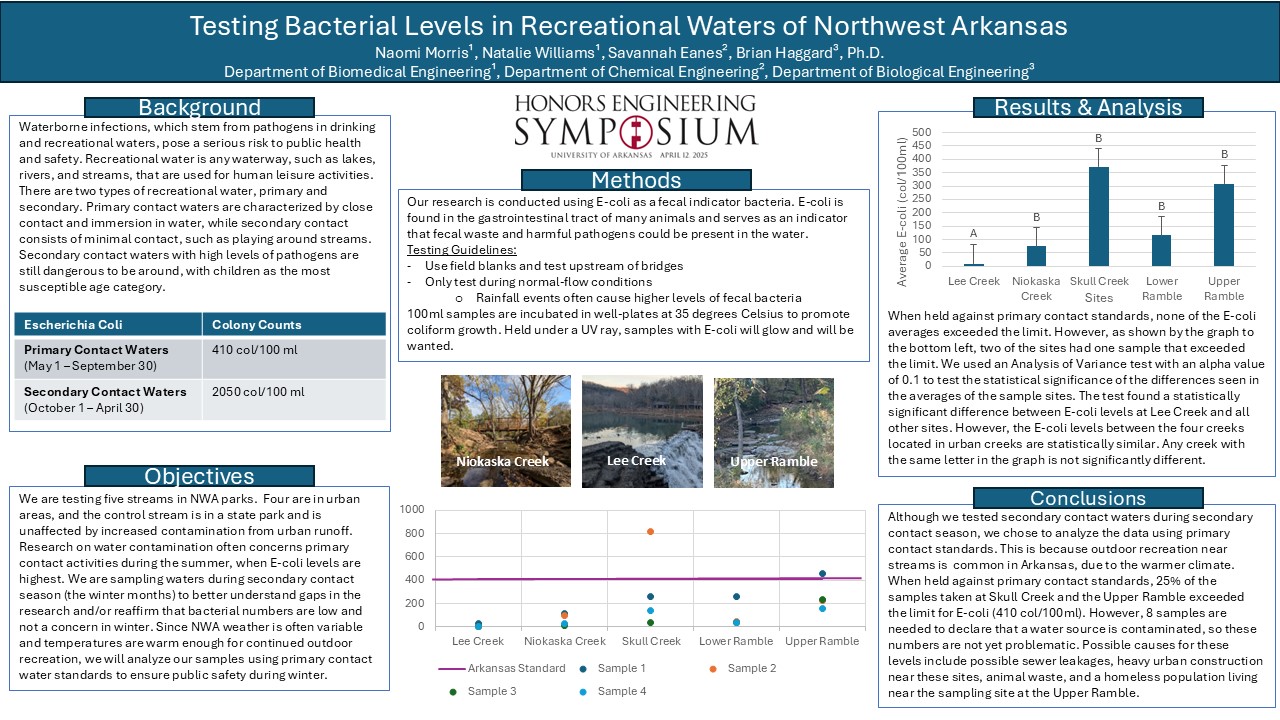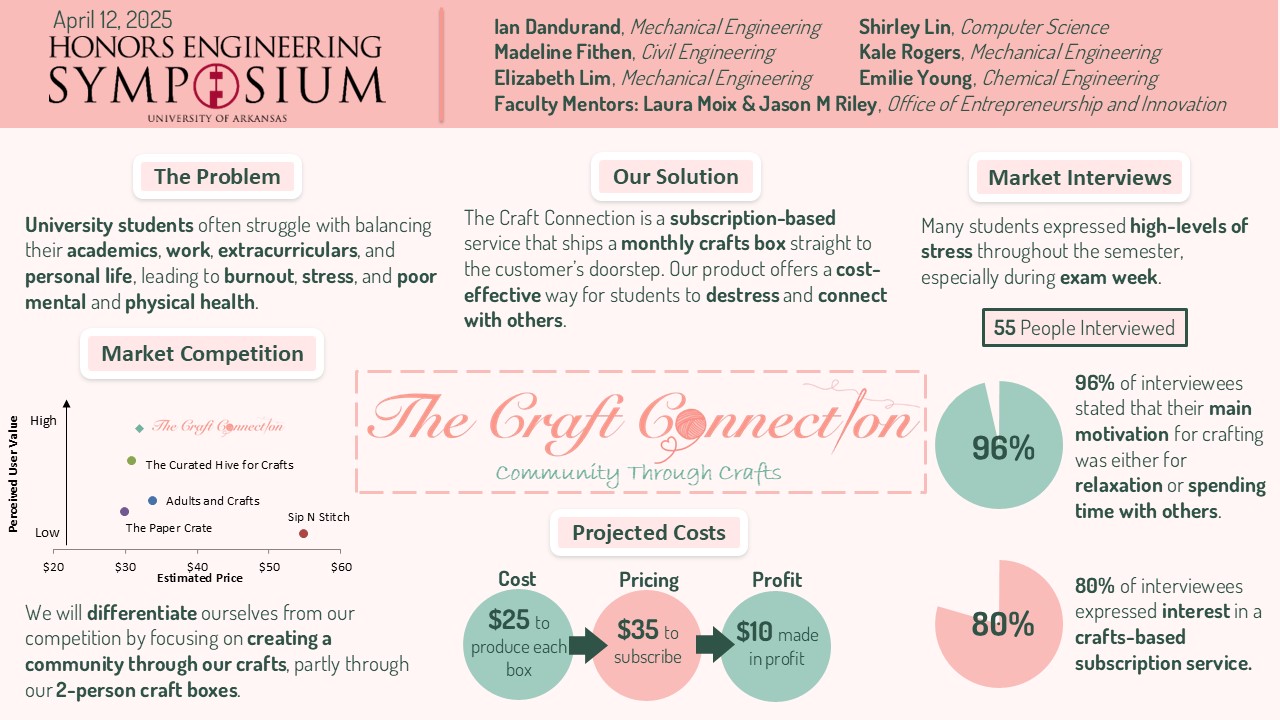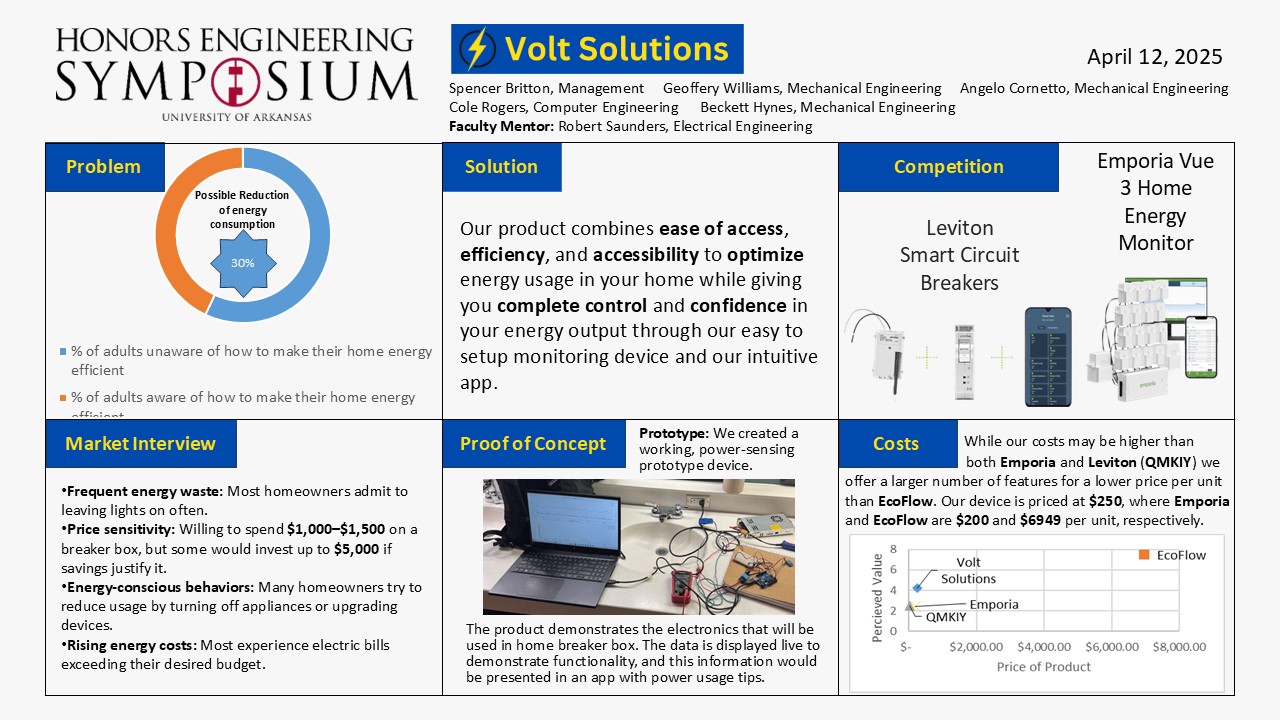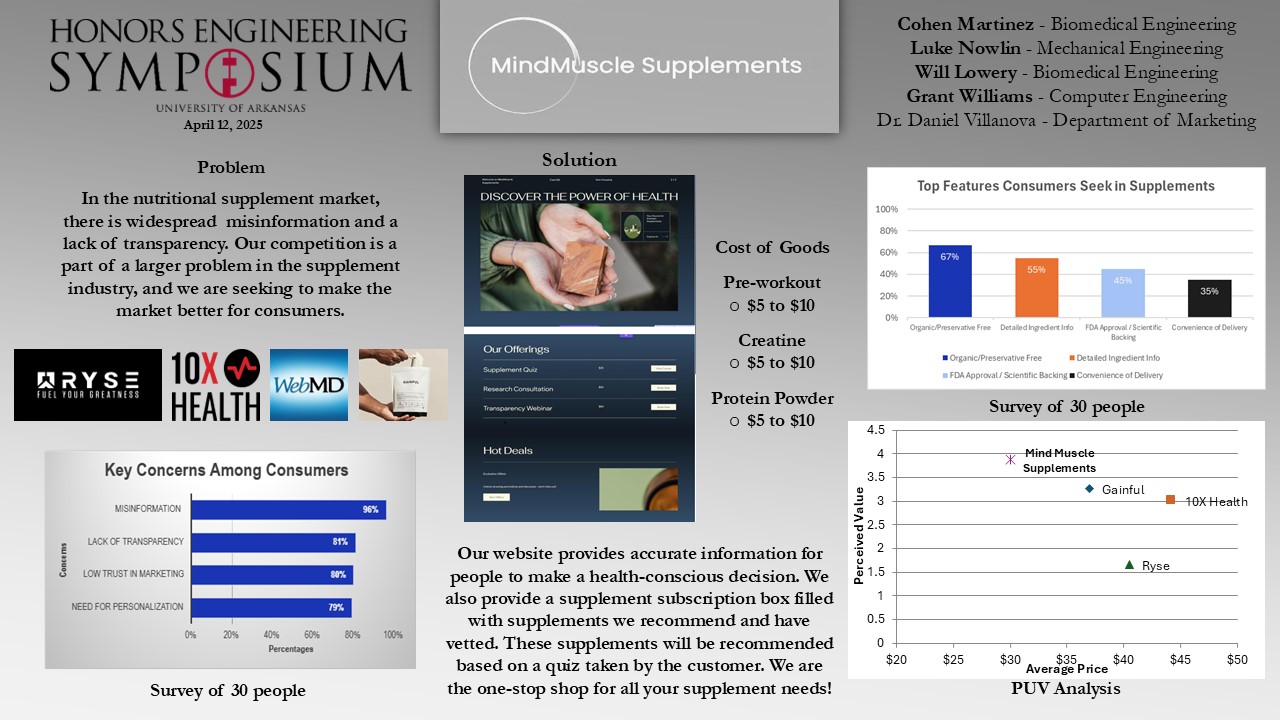17th Annual Honors Engineering Symposium
Saturday, April 12, 2025
Welcome from First-Year Engineering
On behalf of the College of Engineering at the University of Arkansas, it is with great pleasure that we extend a warm welcome to you for the 17th Annual Honors Engineering Symposium. This event spotlights the remarkable achievements of our talented Honors Research and Honors Innovation Experience students, who are part of the Honors College or Honors College Path program.
Throughout the academic year, 62 first-year students from the College of Engineering and Walton College of Business have worked on projects mentored by University of Arkansas faculty members. Engaging in rigorous research colloquia and innovation sessions, these students have learned about various aspects of academia, research, and innovation with unwavering dedication.
The culmination of their efforts will be showcased through 21 compelling research and innovative design projects, covering a diverse spectrum of engineering disciplines. From the intricacies of mechanical engineering to the complexities of electrical systems, each project reflects the passion, intellect, and ingenuity of our emerging engineers and business students.
As we convene for this symposium, attendees will have the opportunity to attend insightful presentations and interactive poster sessions. We encourage everyone to engage with our students, learn about their projects, and participate in vibrant discussions.
We again welcome you to our 17th Annual Honors Engineering Symposium and express our gratitude for your participation. Together, let us celebrate the spirit of inquiry, collaboration, and excellence that defines our vibrant academic community.
Sincerely,
Aysa Galbraith, Ph.D.
Coordinator of Honors Research Experience
Teaching Associate Professor of First-Year Engineering Program
Leslie Massey, M.S.
Coordinator of Honors Innovation Experience
Advanced Instructor of First-Year Engineering Program
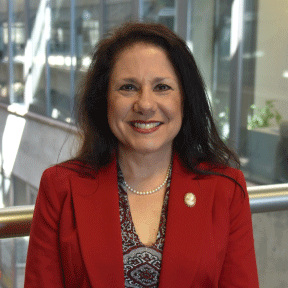
Welcome from the College of Engineering
Hello and welcome to the 17th Annual Honors Engineering Symposium. Today, we honor our students who are shaping the world of tomorrow! Participating in this symposium is a significant achievement, and you should be proud. Well done! You have gone above and beyond what is required of first-year students by choosing to participate in this research or innovation experience and for that we celebrate. Please enjoy the presentations and posters of those who will change research, product marketing and business development of the community, state, nation and the world.
Dean Kim LaScola Needy
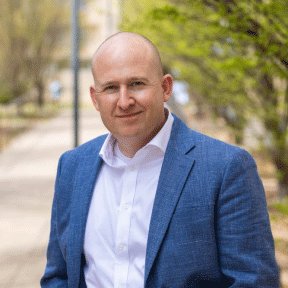
Welcome from the Sam M. Walton College of Business
Welcome to the Honors Engineering Symposium, which showcases the amazing efforts of first-year engineering and business students enrolled in the Honors College and Honors College Path programs. Innovation is one of the values of the Walton College, and I am delighted you have chosen this path. As we look towards the future, it's clear that an innovative and entrepreneurial mindset will be critical in a quickly changing economy. I look forward to the impact you will make, and I congratulate your outstanding work this year!
Dean Brent Williams
Research Teams
Improving Space Thermal Systems with Ti-Encapsulated Graphite
Students
Kaiden Fix | Mechanical Engineering
Faculty Mentor
Han Hu, Ph.D. | Mechanical Engineering
Braden Stevens, P.E. | Graduate Research Assistant Mentor, Mechanical Engineering
Project Description
Our research investigates methods of increasing efficiency of thermal systems in space. We are focused on optimizing radiators by covering graphite sheets with titanium, yielding a strong, flexible material with impressive conductivity. This project has involved exploring different methods of creating composite materials, as well as several thermal tests to prove the validity of this concept. If NASA, our sponsor, approves the validity of our research, it will be implemented into future space thermal systems.
A Qualitative Analysis of Dielectric Barrier Discharge Under Various Wind Conditions
Students
Matt Anderson | Biological Engineering
Zachary Needham | Mechanical Engineering
Manuel Schick-Alba | Civil Engineering
Faculty Mentor
Po-Hao Adam Huang, Ph.D. | Mechanical Engineering
Ethan Graef | Research Assistant Mentor, Mechanical Engineering
Project Description
Due to concerns about pollution, traditional aircraft propulsion alternatives are being explored, such as ionic wind. Ionic wind is generated via dielectric barrier discharge devices, (DBDs), which generate plasma as a byproduct. To test the viability of DBDs for propulsion, we tested them within a wind tunnel, for which we designed and fabricated a mount. Using a motor to change the angle of attack by rotating the mount, we determined effectiveness via the plasma generated.
Design and Development of an Expandable Drone Frame for Airspace Utilization
Students
Ari Mondal | Mechanical Engineering
Chris Ablondi | Mechanical Engineering
Evan Tan | Mechanical Engineering
Faculty Mentor
Uche Wejinya, Ph.D. | Mechanical Engineering
Project Description
Our project researches the feasibility of an expandable drone capable of dynamically adjusting its size mid-flight. This innovation aims to enhance applications in LiDAR mapping, confined space inspections, and efficient storage by adapting to dynamic environments. We developed a mechanical system for in-flight expansion and contraction and are conducting real-world tests to evaluate performance and practicality. In the future, we aim to continue gathering test data and assess its applicability to advance versatile drone design.
The Development of 3D Bioprinted Collagen-Genipin Coated Polycaprolactone Scaffolds for Bone Regeneration and Treatment
Students
Isaac Legate | Mechanical Engineering
Tanner Holden | Mechanical Engineering
Lucas Chance | Biomedical Engineering
Faculty Mentor
Mostafa Elsaadany, Ph.D. | Biomedical Engineering
Aly Navarro | Undergraduate Student Mentor, Biomedical Engineering
Project Description
Current bone injury treatment methods cause stress shielding and other negative side effects. We are developing a biocompatible, biodegradable bone implant that can replace traditional bone injury treatments using collagen-genipin coated polycaprolactone (PCL) scaffolds. The idea is to seed osteoblast precursor cells onto the PCL scaffolds in order to promote bone regeneration at the site of injury.
Testing Bacterial Levels in Recreational Waters of Northwest Arkansas
Students
Naomi Morris | Biomedical Engineering
Natalie Williams | Biomedical Engineering
Savannah Eanes | Chemical Engineering
Faculty Mentor
Brian E. Haggard, Ph.D. | Biological Engineering, Director of Arkansas Water Resources Center
Project Description
Waterborne infections, which stem from pathogens in drinking and recreational waters, pose a serious risk to public health and safety. This project tests bacterial numbers in recreational streams in Northwest Arkansas during the winter months using E-coli as a fecal indicator bacteria. Our group compared E. coli numbers across the selected streams and to the primary contact standards for bacteria in Arkansas.
Comparing the Mechanical Power Output of Using Two Motors versus Four Motors in Various Scenarios
Students
Hayden Daniel | Electrical Engineering
Andrew Escue | Computer Engineering
Gabe Melton | Mechanical Engineering
Faculty Mentor
Jeff Dix, Ph.D. | Electrical Engineering and Computer Science
Project Description
This project tests the mechanical power output of motors attached to a robot car when it drives at different angles of incline, and compares the power output of the motors when the robot uses two of them (two wheel drive) to the power output of the motors when the robot uses all four (all wheel drive).
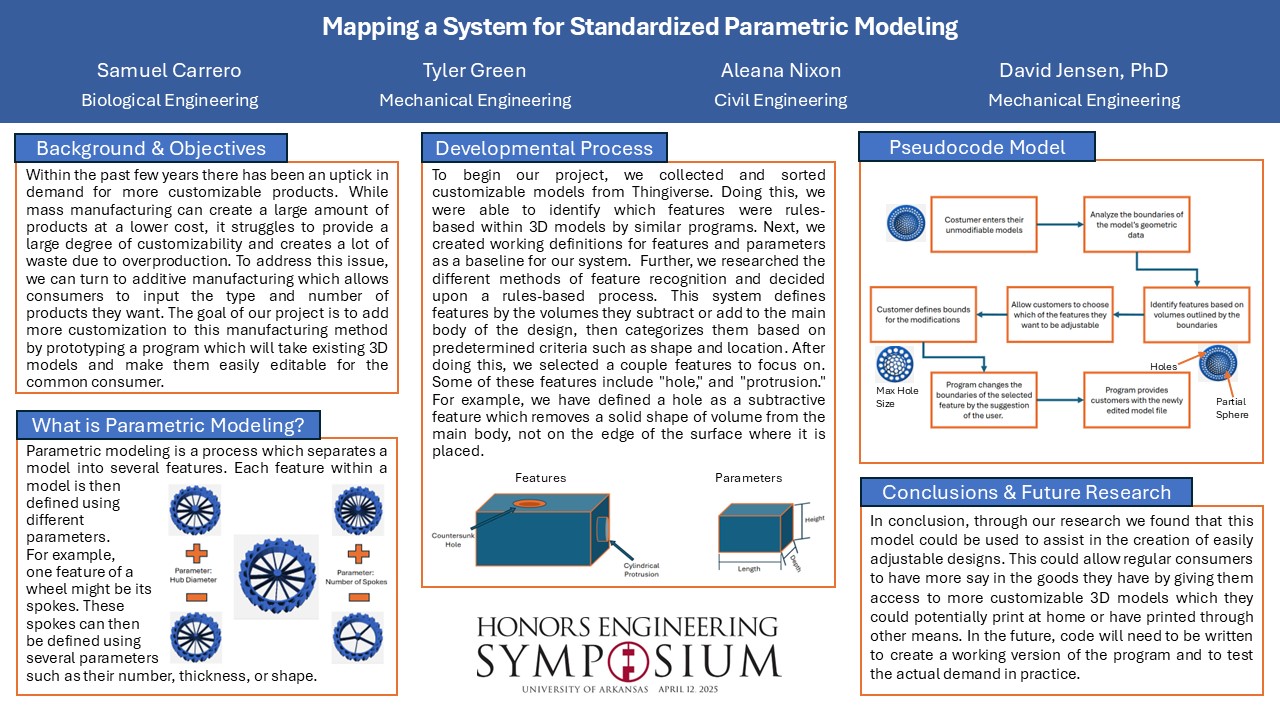
Mapping a System for Standardized Parametric Modeling
Students
Tyler Green | Mechanical Engineering
Aleana Nixon | Civil Engineering
Samuel Carrero | Biological Engineering
Faculty Mentor
David C Jensen, Ph.D. | Mechanical Engineering
Project Description
As personalized goods have increased in popularity, parametric 3D modeling has become a vital tool in the world of manufacturing, allowing customers to edit the parameters of various features on their designs to fit their specific purpose. By creating a system which standardizes the adjustment of these features, we make this process more accessible to the average consumer. This system will assist designers by allowing them to easily modify features on a multitude of projects.
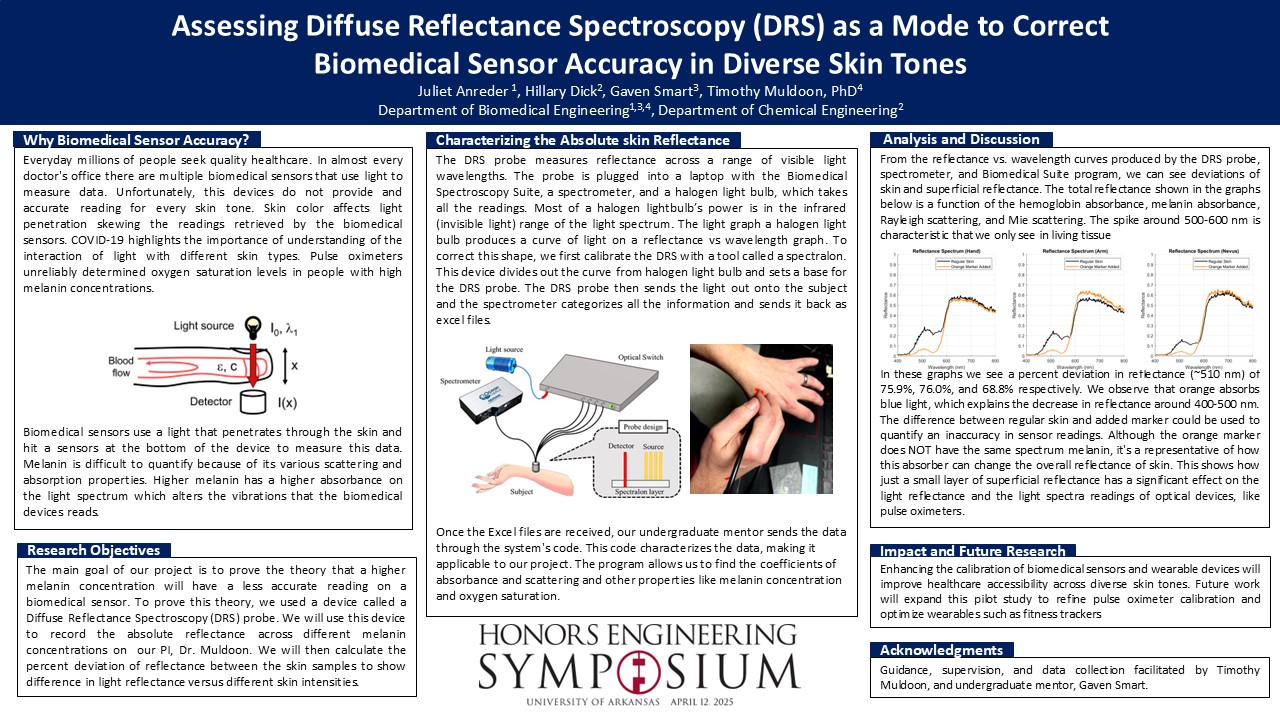
Assessing Diffuse Reflectance Spectroscopy as a Mode to Correct Biomedical Sensor
Accuracy in Diverse Skin Tones
Students
Juliet Anreder | Biomedical Engineering
Hillary Dick | Chemical Engineering
Faculty Mentor
Timothy Muldoon, Ph.D.. M.D. | Biomedical Engineering
Gaven Smart | Undergraduate Student Mentor, Biomedical Engineering
Project Description
Many medical devices, like pulse oximeters, have concerning limitations in accurately measuring oxygen saturation in individuals with higher melanin concentrations. Using a diffuse reflectance spectroscopy (DRS) probe, we quantify the relationship between light intensity and skin reflectance across varying skin tones. By analyzing percent differences, we highlight the need for recalibrating these devices to improve accuracy and reduce healthcare disparities, ensuring adequate care for everyone.
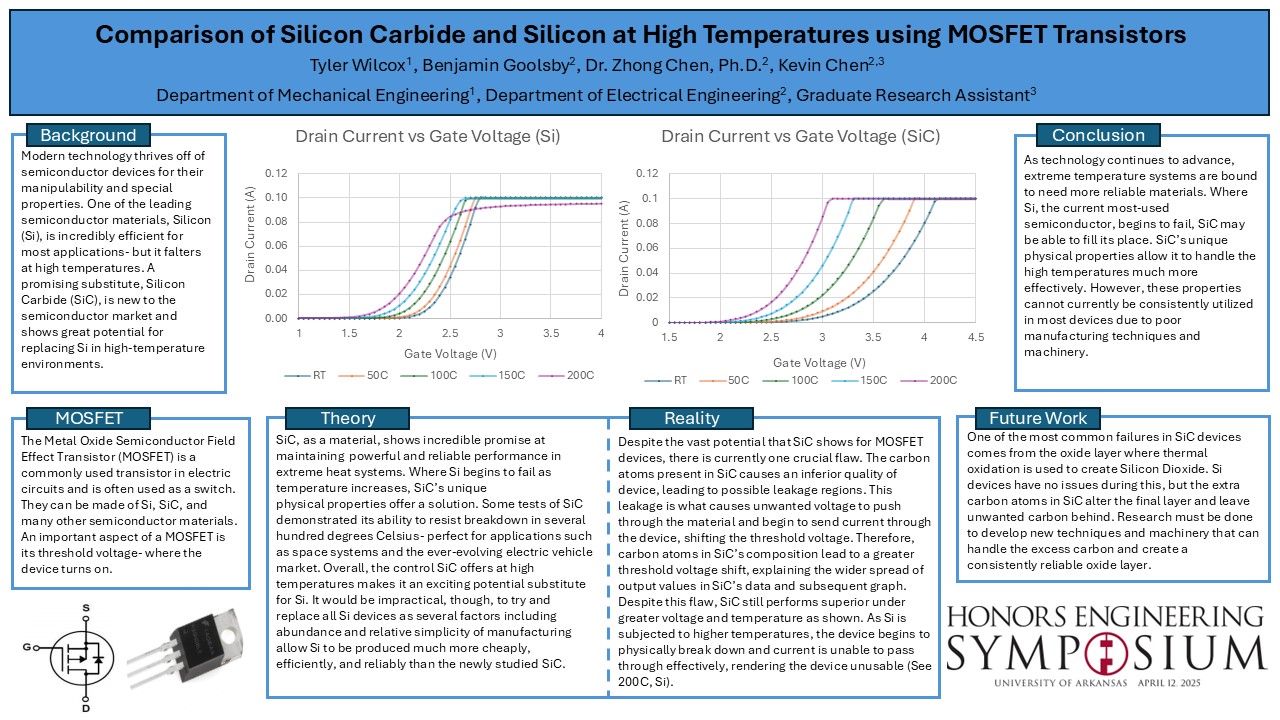
Comparison of Silicon Carbide and Silicon at High Temperatures using MOSFET Transistors
Students
Benjamin Goolsby | Electrical Engineering
Tyler Wilcox | Mechanical Engineering
Faculty Mentor
Zhong Chen, Ph.D. | Electrical Engineering and Computer Science
Kevin Chen, M.S. | Graduate Research Assistant Mentor, Electrical Engineering
Project Description
This project investigates the performance of silicon and silicon carbide MOSFETs -electronic switches - in high-temperature environments. Silicon carbide generally demonstrates superior thermal resilience and energy efficiency, making it a promising option for demanding applications such as renewable energy and aerospace technology. The research focuses on identifying the optimal choice for harsh conditions where durability and reliability are essential and highlights silicon carbide’s potential in fulfilling such a crucial market.
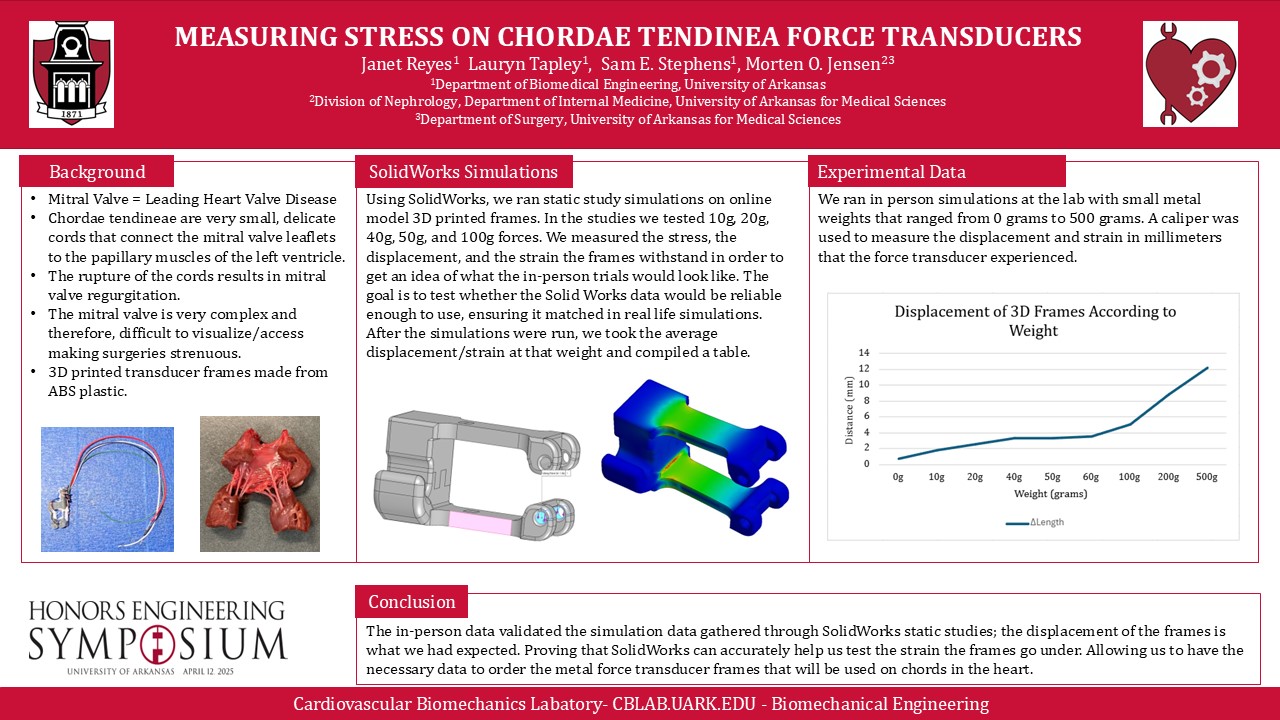
Measuring Stress on Chordae Tendineae Force Transducers
Students
Janet Reyes | Biomedical Engineering
Lauryn Tapley | Biomedical Engineering
Faculty Mentor
Morten O. Jensen, Ph.D., Dr.Med | Biomedical Engineering, Internal Medicine UAMS
Sam E. Stephens | Program Diretor and Mentor, Biomedical Engineering
Project Description
We measured stress, strain, and displacement on force transducers that will be used on the chordae tendineae in the mitral valve. The transducer utilizes 3D-printed cantilever frames. SolidWorks simulations were run to analyze the forces on these frames under forces ranging from 0.1 to 2.0 Newtons. These simulations help ensure the frames are flexible yet sufficiently strong and reliable for accurate measurements. To check the reliability of the SolidWorks data, we ran in person tests.
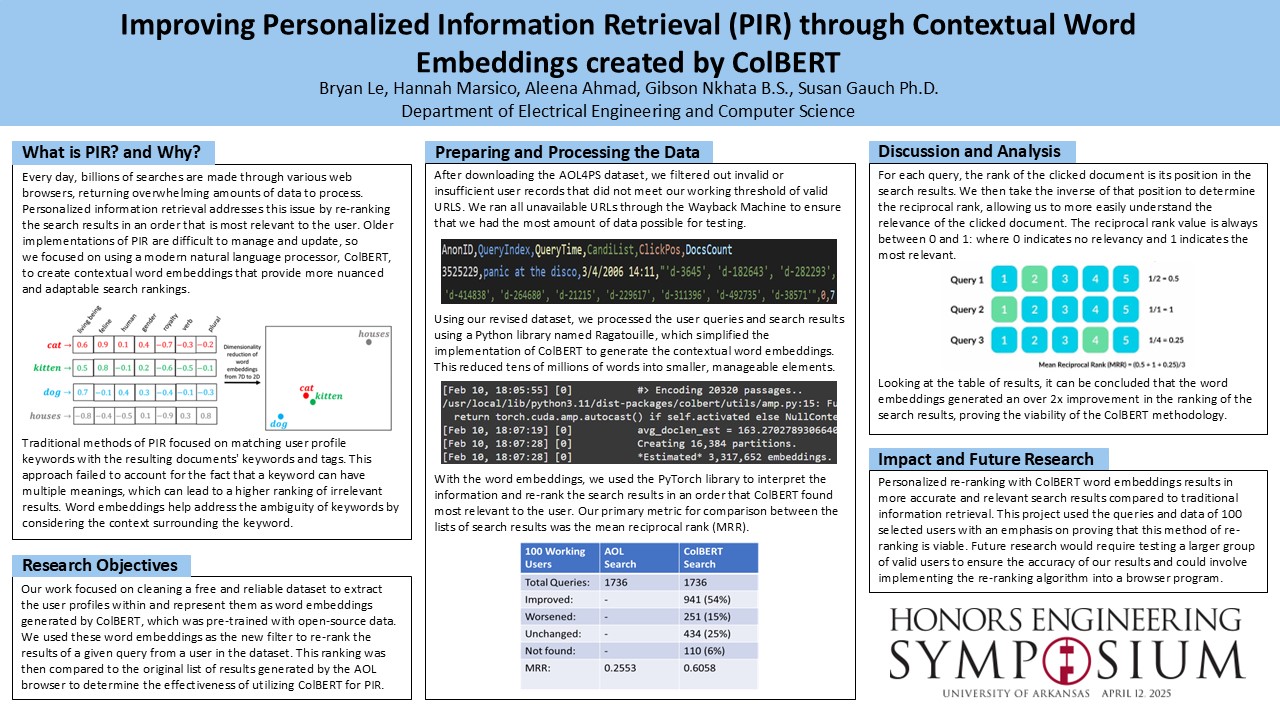
Improving Personalized Information Retrieval through Contextual Word Embeddings created
by ColBERT
Students
Bryan Le | Computer Science
Hannah Marsico | Computer Science and Computer Engineering
Faculty Mentor
Susan Gauch, Ph.D. | Electrical Engineering and Computer Science
Aleena Ahmad | Undergraduate Student Mentor, Electrical Engineering and Computer Science
Gibson Nkhata | Graduate Research Assistant Mentor, Electrical Engineering and Computer
Science
Project Description
Every day, billions of searches are made through various web browsers, returning overwhelming amounts of data to process. Personalized information retrieval (PIR) addresses this issue by re-ranking the search returns in an order that is most relevant to the user. Older implementations of PIR are difficult to manage and update, so this project focuses on using a modern natural language processor, ColBERT, to create contextual word embeddings that provide more nuanced and adaptable search rankings.
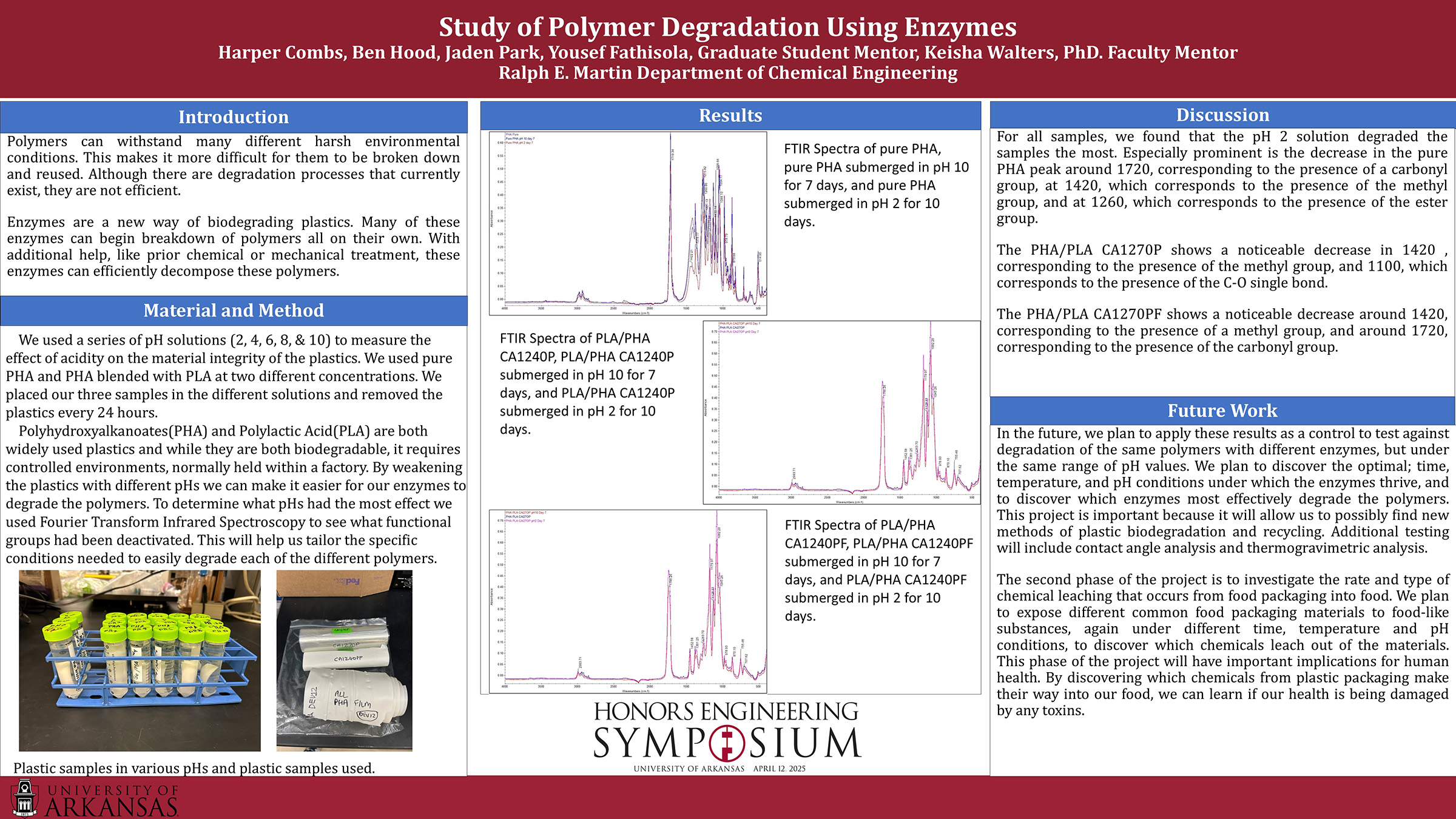
Study of Polymer Degradation Using Enzymes
Students
Harper Combs | Chemical Engineering
Ben Hood | Chemical Engineering
Jaden Park | Chemical Engineering
Faculty Mentor
Keisha B. Walters, Ph.D. | Chemical Engineering
Yousef Fathisola | Graduate Student Mentor, Chemical Engineering
Project Description
Synthetic plastics play a crucial role in daily life. However, most plastics are single-use, causing a large portion of the plastics end up becoming wastes, and plastic waste generation is increasing. Traditional disposal methods like landfilling and incineration have significant environmental drawbacks while recycling faces limitations in efficiency and material degradation. In this project, we will study enzymatic biodegradation, a process by which enzymes break down polymer chains, under different environmental conditions to enhance our understanding of the mechanisms involved.
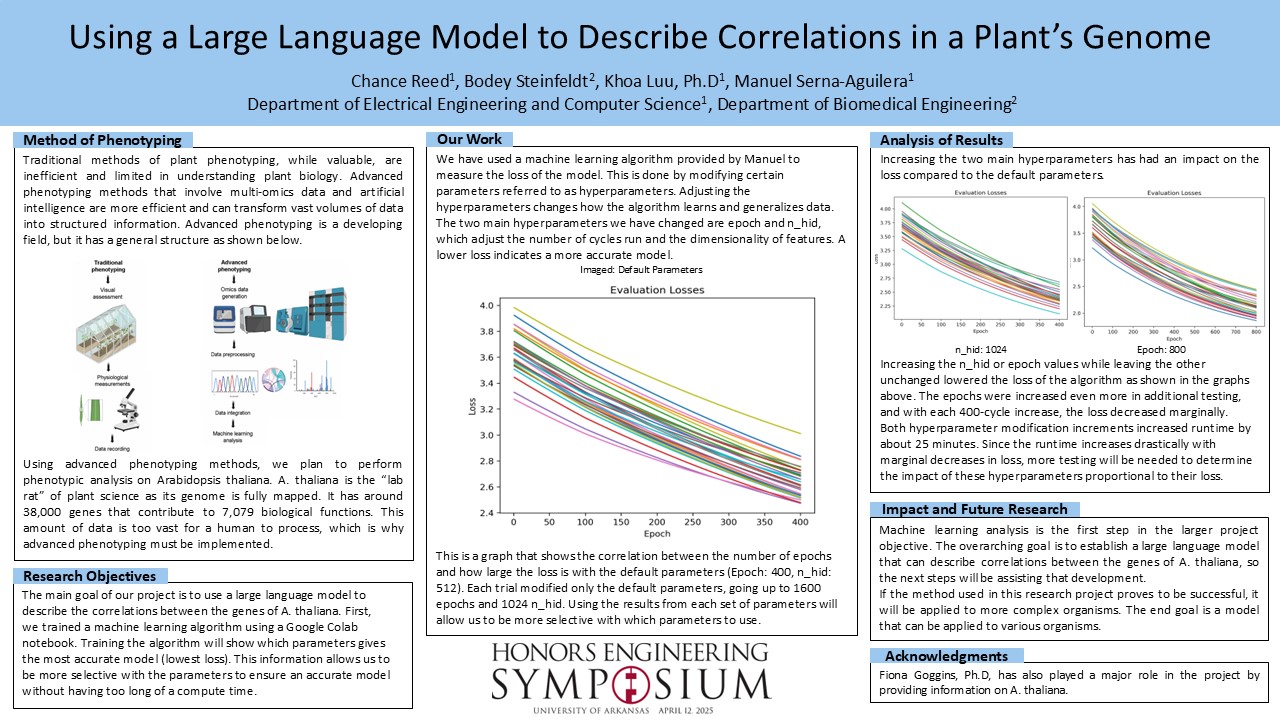
Using Machine-Learning to Describe Correlations in a Plant's Genome
Students
Boden William Steinfeldt | Biomedical Engineering
Chance Von Reed | Computer Science
Faculty Mentor
Khoa Luu, Ph.D. | Electrical Engineering and Computer Science
Manuel Serna-Aguilera | Graduate Student Mentor, Electrical Engineering and Computer
Science
Project Description
This project consists of us experimenting with a machine-learning algorithm that depicts the correlation between plant genes and how they interact. There are roughly 38,000 genes in the genome of Arabidopsis thaliana with about 150,000 connections between the genes and 7,079 known biological functions. This project aims to familiarize ourselves with machine learning and understand how genes affect one another, directly and indirectly, concerning the many different biological functions.
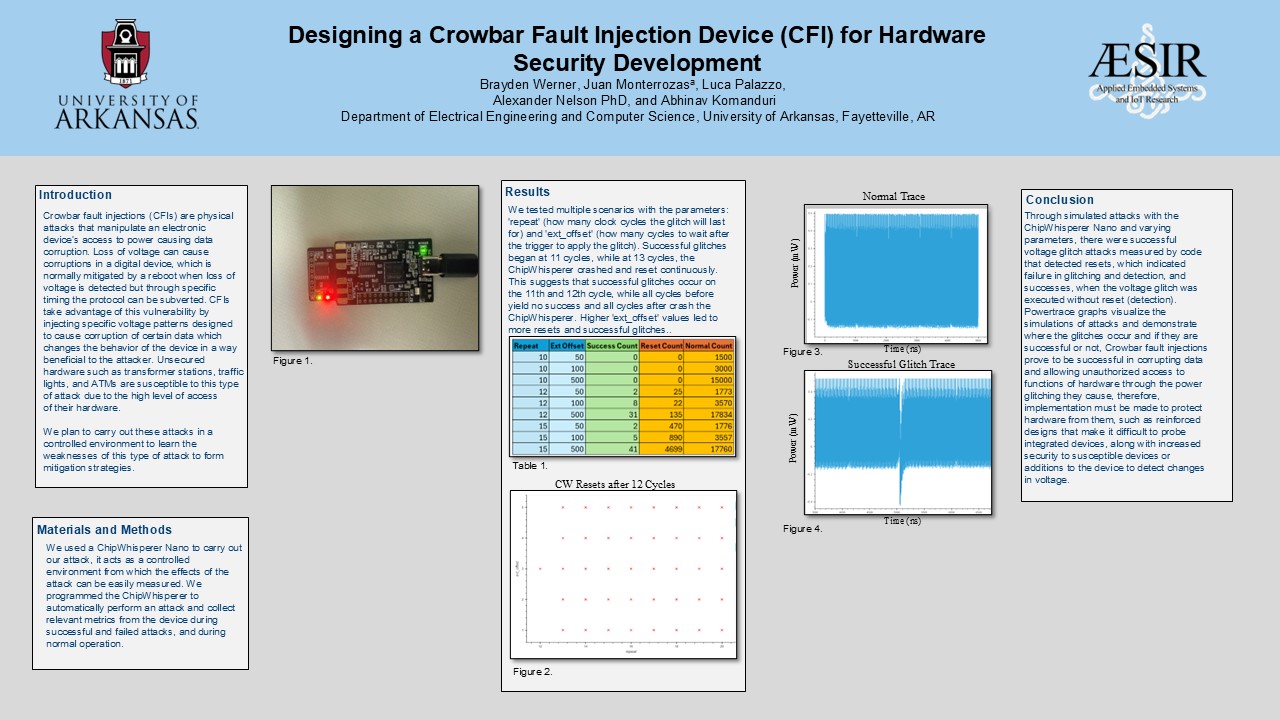
Designing a Crowbar Fault Injection Device (CFI) for Hardware Security Development
Students
Brayden Werner | Computer Science
Juan Monterrozas | Electrical Engineering
Luca Palazzo | Computer Science
Faculty Mentor
Alexander Nelson, Ph.D. | Electrical Engineering and Computer Science
Abhinav Komundari | Undergraduate Student Mentor, Electrical Engineering and Computer
Science
Project Description
Crowbar Fault Injections (CFI) are physical attacks on devices that exploit vulnerabilities in their hardware in order to extract sensitive information or cause damage. Currently, there is little research on these attacks, so embedded systems within systems such as medical devices or transformer stations are vulnerable. Because of this, we have designed and tested a CFI device in order to better understand its vulnerabilities and develop ways to better protect against its attacks. Through our research with complete access to probe and inject faults, we have discovered that through certain parameters successful glitch injections can occur undetected. However, without physical access to the device, it is impossible to inject this type of fault. Additionally, there are hardware components that can detect these anomalies and reset the system.
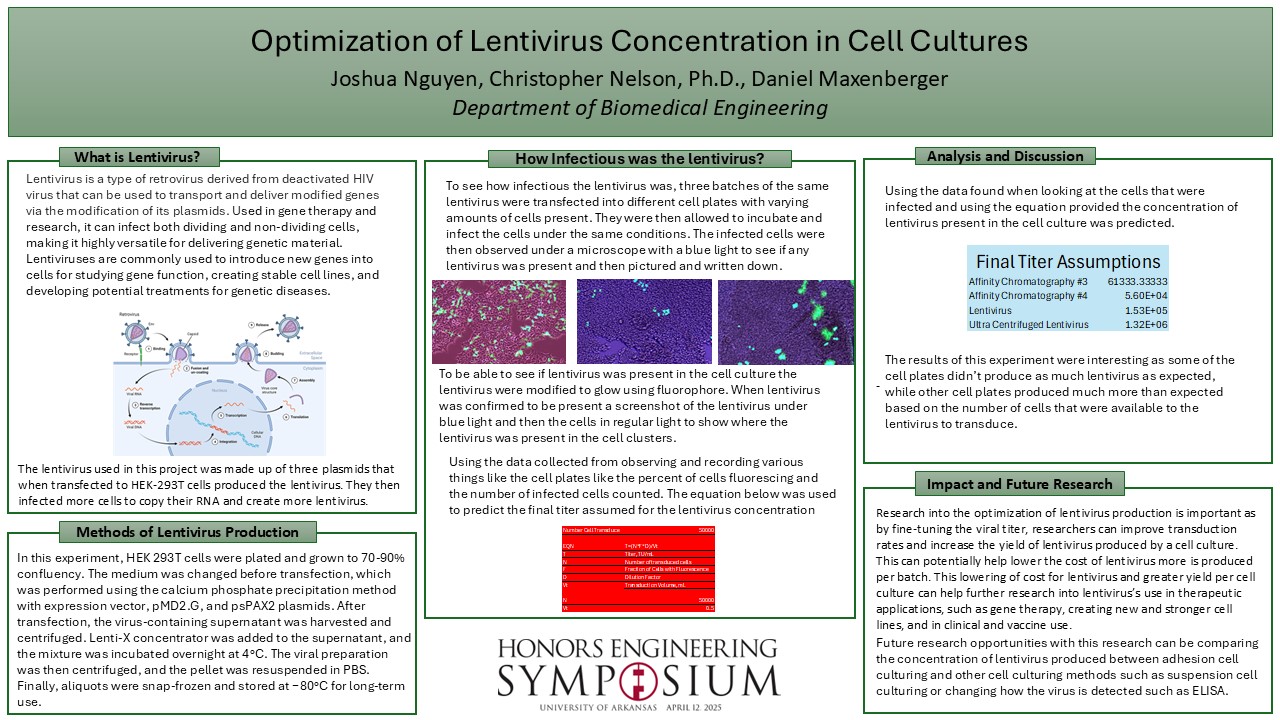
Optimizing Lentivirus Concentration in Adhesion and Suspension Cell Cultures
Students
Joshua Nguyen | Biomedical Engineering
Faculty Mentor
Christopher Nelson, Ph.D. | Biomedical Engineering
Daniel Maxenberger | Graduate Student Mentor, Biomedical Engineering
Project Description
Lentivirus and other gene delivering tools play important roles in various medical practices such as gene therapy and the production of vaccines. However, the production of these vital gene tools is expensive, thus the need to find ways to produce more of these particles per production cycle. This project aims to find a more efficient and practical production method using adhesion and suspension cell culturing to produce the maximum potential concentration of lentivirus possible.
Innovation Teams
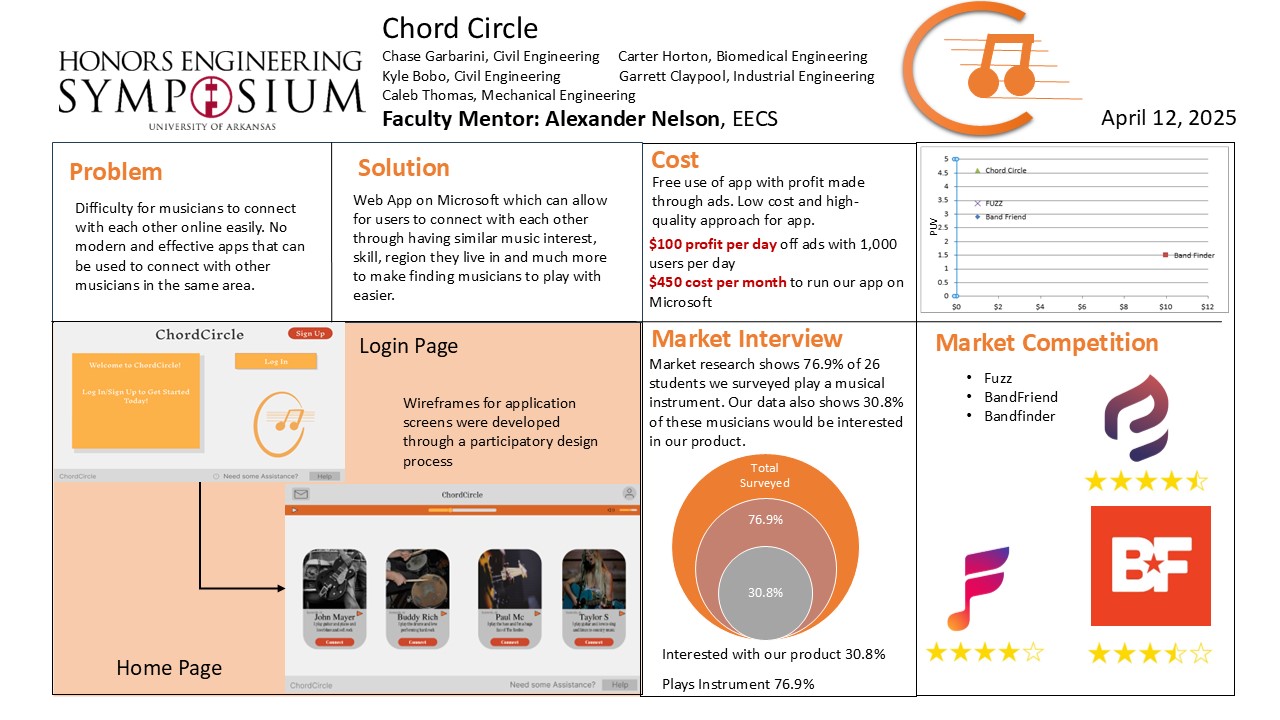
ChordCircle
Students
Kyle Bobo | Civil Engineering
Caleb Thomas | Mechanical Engineering
Garrett Claypool | Industrial Engineering
Carter Horton | Biomedical Engineering
Chase Garbarini | Civil Engineering
Faculty Mentor
Alex Nelson, Ph.D. | Electrical Engineering and Computer Science
Project Description
ChordCircle is like a dating app for bands. It revolutionizes the world of band building by adding not only what you play but also your favorite kinds of music and personal taste. This allows for people who are interested in playing in a band but don't have the ability to reach out to find others to join.

Questudy
Students
Daniel Choi | Computer Engineering
Araceli Rodriguez | Mechanical Engineering
Emily Noack | Chemical Engineering
Faculty Mentor
Gretchen Scroggin, M.S. | First Year Engineering
Curtis Maughan, Ph.D. | World Languages, Literatures & Cultures
Project Description
Do you wish you could go back to the days when studying was fun? Questudy aims to fill that gaping hole in your mind! Inspired by the math game Prodigy, Questudy is an adaptive, interactive studying experience that doubles as a customizable story-rich RPG. The progress tracking system tracks a user's mastery of a skill and allows one to study at their own pace and intensity! Make studying a game, not a pain!
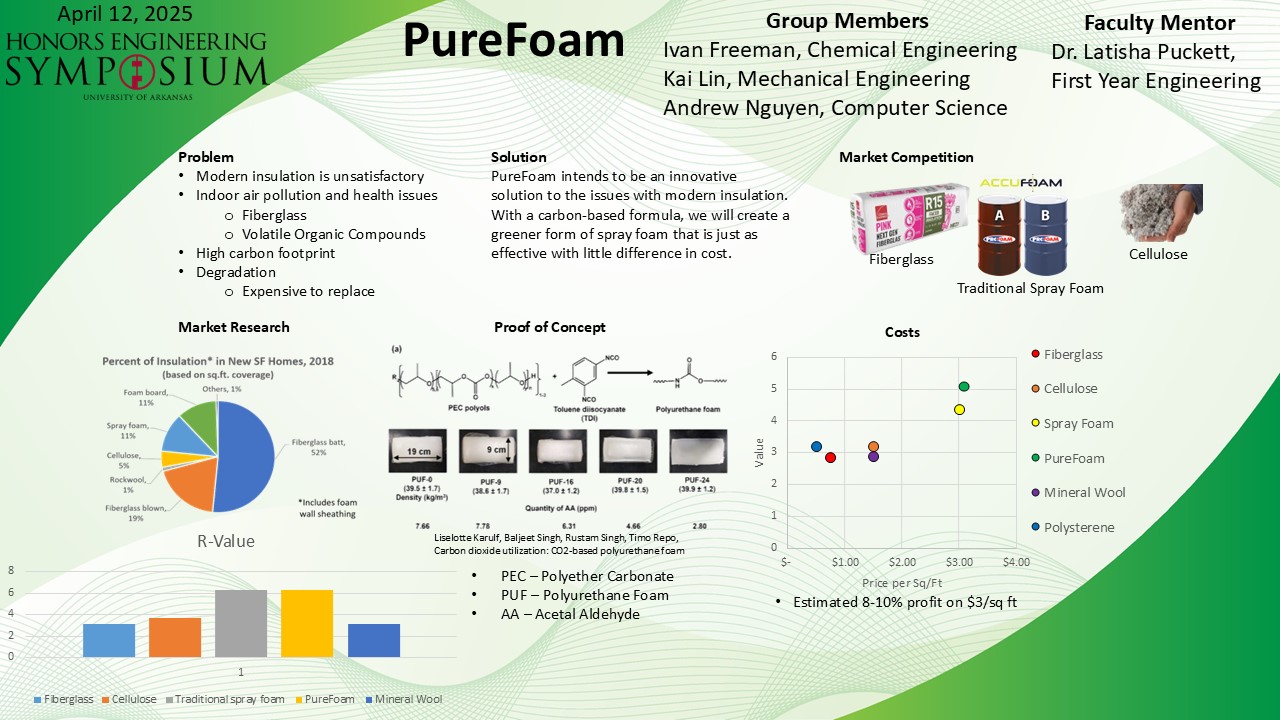
PureFoam
Students
Ivan Freeman | Chemical Engineering
Kai Lin | Mechanical Engineering
Andrew Nguyen | Computer Science
Faculty Mentor
Latisha Puckett, Ph.D. | First Year Engineering
Project Description
Insulation is often unclean, posing hazards to both people and the planet. PureFoam’s advanced formulation harnesses captured Carbon Dioxide to solve these issues without sacrificing cost or performance. Its insulation power rivals leading spray foam products, yet it’s made with a far cleaner formula. The result? A healthier, purer living environment for everyone.
The Craft Connection: Community through Crafts
Students
Ian Dandurand | Mechanical Engineering
Madeline Fithen | Civil Engineering
Elizabeth Lim | Mechanical Engineering
Shirley Lin | Computer Science
Kale Rogers | Mechanical Engineering
Emilie Young | Chemical Engineering
Faculty Mentor
Laura Moix, M.A. | College of Engineering Entrepreneurship & Innovation
Jason Riley, M.Ed. | Walton College of Business
Project Description
Do exams have you down? Is it difficult to find ways to relax and explore new activities? Well, our product is a subscription-based service that ships boxes full of creativity to your doorstep every month! We offer you a pathway to create new experiences and artistic displays with people like you, and at The Craft Connection, you build Community through Crafts.
Volt Solutions
Students
Geoffery Williams | Mechanical Engineering
Cole Rogers | Computer Engineering
Angello Cornetto | Mechanical Engineering
Beckett Hynes | Computer Engineering
Spencer Britton | Management, WCOB
Faculty Mentor
Robert Saunders, M.S. | Electrical Engineering & Computer Science
Project Description
Unnecessary energy waste is a costly problem for homeowners. Volt Insight provides a smart breaker solution that tracks real-time electricity usage, helping users optimize energy consumption and reduce expenses. Our wireless switches integrate with an intuitive app to monitor, control, and suggest energy-saving strategies. Designed for efficiency and affordability, Volt Insight empowers homeowners to take control of their energy usage, minimize phantom energy waste, and lower their utility bills.
MindMuscle Supplements
Students
Will Lowery | Biomedical Engineering
Luke Nowlin | Mechanical Engineering
Cohen Martinez | Biomedical Engineering
Grant Williams | Computer Engineering
Faculty Mentor
Daniel Villanova, Ph.D. | Marketing
Project Description
MindMuscle Supplements is committed to transparency and trust in the supplement industry. We provide free, science-backed services to help you understand what’s really in your supplements. Our expert analysis ensures you make informed choices about quality, safety, and effectiveness—no gimmicks, just honest insights. Your health and performance matter, and we’re here to empower you with the knowledge you need. MindMuscle Supplements: because what you take should be as strong as you are.
